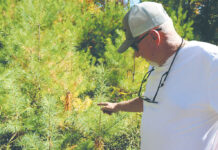The best way to avoid getting a tick-borne disease is to avoid getting bitten by a tick. And the best way to do that is to avoid contact with ticks by staying out of tick habitats (wooded and brushy areas with high grass and leaf litter). But this advice doesn’t work so well for farmers and other folks who work outdoors.
If you can’t avoid tick habitats, here are some things you can do to prevent tick bites:
Before you go outside
• Treat your shoes, clothes and gear with products containing 0.5% permethrin, an insecticide that kills ticks. You cannot apply permethrin directly to your body, and it needs time to dry before you can put treated clothes on, so you need to plan ahead for this step. Permethrin remains protective through several washings. Alternatively, you can buy permethrin-treated clothing and gear.
• Wear light-colored clothes (helps you see ticks), long socks, long pants and long-sleeved shirts (This is also a good way to avoid sun exposure, lowering your risk of developing skin cancer. Farmers and ag workers have an increased risk of skin cancer because of all the time they spend outside).
• Tuck your shirt into your pants and your pant legs into long socks.
While you’re out
• Use EPA-registered insect repellents on your body and clothes. A repellent won’t kill the ticks like permethrin will, but it makes you less attractive to ticks and other pests. Find a list of repellents here: epa.gov/insect-repellents
• Check for ticks frequently. Don’t wait until you get home.
• Run a lint roller over your clothes to pick up small ticks that are hard to see.
When you get home
• Do a full-body tick check. Check under your arms, in and around ears, inside the belly button, back of the knees, in and around hair, between the legs and around the waist.
• Check your clothes, pets and gear for ticks.
• Get a shower as soon as possible to wash off unattached ticks.
• Tumble your clothes in a clothes dryer on high for at least one hour before washing to kill any ticks. Washing alone will not kill ticks.
Extra tips
• Watch your pets: Ticks can hitch a ride on your livestock and your pets, especially those that roam the farm with you (looking at you, farm dogs and barn cats). Keep up with tick prevention on your pets and check yourself after interacting with animals that have been in tall grassy areas.
• Removing ticks: If you find a tick attached to your body, remove it. Use tweezers, grab the tick as close as you can to its head and steadily pull the tick straight up and out. Put the offending tick in a plastic bag for safekeeping, so you can identify it and have it tested for tick-borne pathogens. Clean the bite with an antiseptic and keep an eye on it. Some redness at the bite site is normal, but it should subside. Watch for signs of infection. See your doctor if you develop a rash, tenderness or pain.
• Test your tick: There are labs that will analyze your tick and test for tick-borne diseases like Lyme disease, anaplasmosis and Rocky Mountain spotted fever. Click the links below for the labs in Ohio and Pennsylvania.
Ohio State Buckeye Tick Test Lab
Tick Research Lab of Pennsylvania
Source: CDC, Alpha-gal information, Penn State Extension










